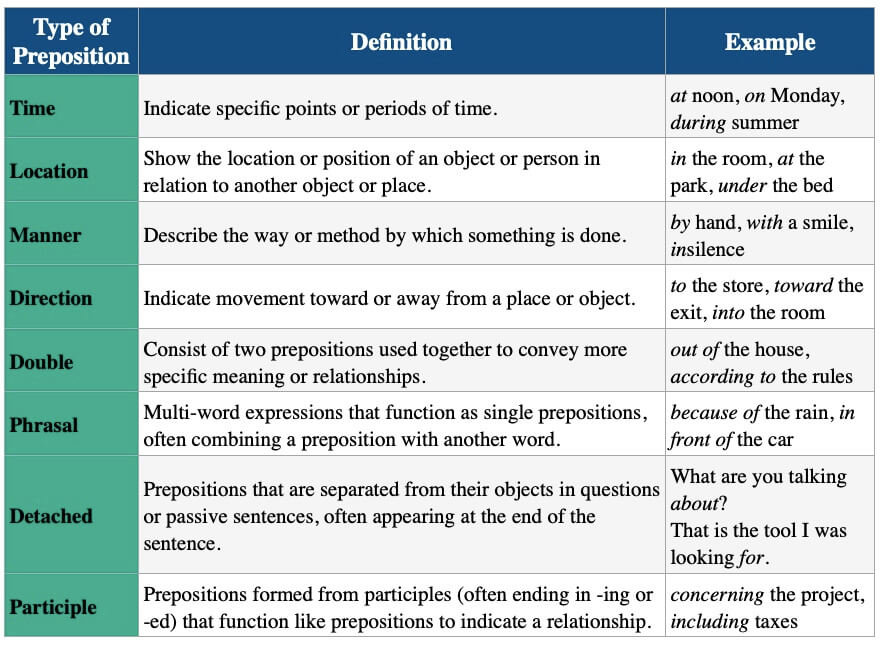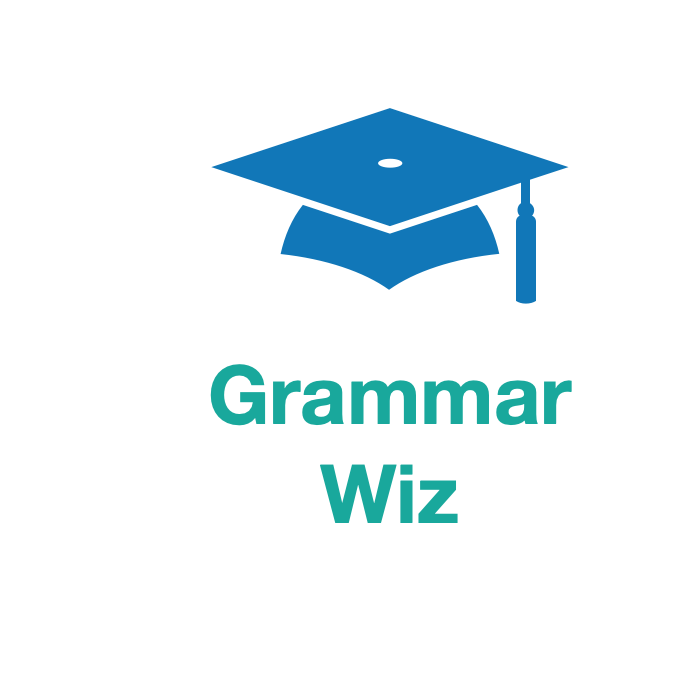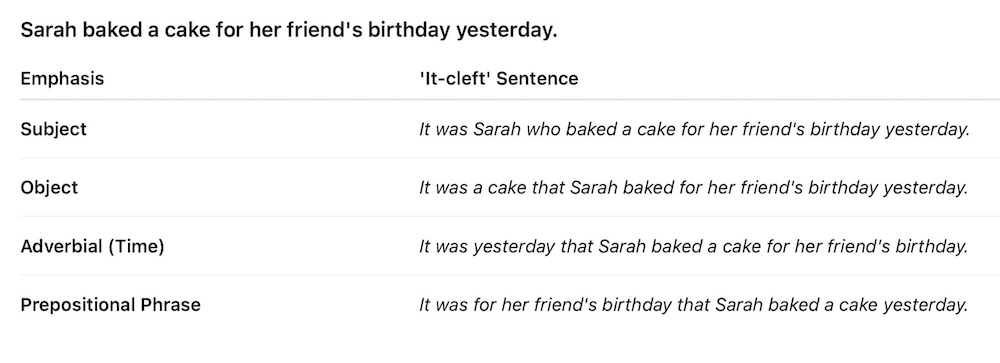- Home
- Grammar Lessons
- Classification of Prepositions in English
Classification of Prepositions in English
This lesson looks at the classification of prepositions in English and provides a comprehensive list of prepositions with examples.
On this page:
- Prepositions of Time
- Prepositions of Location
- Prepositions of Manner
- Prepositions of Direction
- Double Prepositions
- Phrasal Prepositions
- Detached Prepositions
- Participle Prepositions
Prepositions of Time
Prepositions of time are words that link nouns or pronouns to a point or period of time.
- At – for precise times or specific points in time.
at 5 o'clock, at noon, at night, at the weekend. - On – for days and dates.
on Monday, on July 4th, on Christmas Day, on my birthday. - In – for longer periods such as months, years, centuries, and long durations.
in the morning, in 2020, in December, in the 21st century. - By – to indicate a deadline or the latest time something will happen.
by tomorrow, by 5 pm, by the end of the year. - From...to/until – to describe the start and end of a time period.
from 9 am to 5 pm, from Monday to Friday. - Since – to describe the starting point of an action that continues to the present.
since 1995, since last week. - For – to indicate a period of time during which something happens.
for two hours, for five years. - During – to express when something happens within a time period.
during the meeting, during the summer, during the war. - Until/till – to describe up to a specific time.
until midnight, till next week. - After – for something that happens following a time or event.
after lunch, after 5 pm. - Before – for something that happens prior to a time or event.
before dinner, before the meeting. - Within – to indicate a time frame in which something will happen.
within a week, within two hours.
Prepositions of Location (or Place)
Prepositions of place are a type of preposition used to show the position or location of something.
- In – inside a space or an enclosed area.
in the room, in the box, in the city. - On – on a surface.
on the table, on the wall, on the floor. - At – specific points or locations.
at the bus stop, at the corner, at the entrance. - Under – below or beneath something else.
under the table, under the bed, under the bridge. - Over – above or covering something else.
over the roof, over the mountains, over the desk. - Above – higher than something else, but not necessarily directly over it.
above the clouds, above the door, above the shelves. - Below – lower than something else.
below the surface, below the belt, below the picture. - Next to – beside or close to something else.
next to the car, next to the house, next to the park. - Beside – at the side of something else.
beside the river, beside the chair, beside the road. - Between – in the space separating two objects or points.
between the two buildings, between the trees, between you and me. - Behind – at the back of something else.
behind the door, behind the house, behind the curtain. - In front of – positioned ahead of something else.
in front of the TV, in front of the car, in front of the school. - Near – proximity; close to something else.
near the station, near the beach, near the airport. - Opposite – facing or across from something else.
opposite the street, opposite the store, opposite the park. - By – proximity or being beside something.
by the window, by the door, by the river. - Inside – within or enclosed by something.
inside the box, inside the house, inside the car. - Outside – not within or is on the exterior.
outside the building, outside the gate, outside the store. - Across from – used to show something located on the opposite side.
the bank is across from the store.
Test yourself in this prepositions of location quiz >>
Prepositions of Manner
Prepositions of manner describe how or in what manner an action is performed. it answers the question "How...?". e.g. Q: How did you get here? A: By train.
- By – the means or method of doing something.
by train, by hand, by accident. - With – the tool, object, or characteristic used to do something.
with a knife, with a smile, with care. - Without – the absence of something in performing an action.
without hesitation, without a doubt, without help. - Like – similarity or comparison.
like a professional, like a dream, like lightning. - In – to describe the state or condition in which something is done.
in silence, in a hurry, in a friendly manner. - As – the role or function of something or someone.
as a teacher, as a guide, as a leader. - Through – the means of achieving something.
through hard work, through perseverance, through determination. - About – a general manner or attitude.
careful about details, anxious about the results, optimistic about the future.
Test yourself in this prepositions of manner quiz >>
Prepositions of Direction
These types of preposition indicate the path, orientation, or movement from one place to another
- To – toward a specific destination or goal.
go to the park, walk to the door, drive to the city. - Towards – in the direction of something, though not necessarily reaching it.
walk towards the bridge, move towards the light. - Into – from outside to the inside of something.
go into the house, jump into the pool.
- Onto – from a lower to a higher position on a surface.
climb onto the roof, jump onto the bed. - Across – from one side to the other of something.
run across the street, swim across the river. - Along – in a line following the length of something.
walk along the beach, drive along the road. - Up – to a higher position.
climb up the stairs, run up the hill. - Down – to a lower position.
walk down the hill, fall down the stairs. - Out of – from inside to outside.
get out of the car, run out of the building.
- From – the starting point of movement.
travel from Paris, run from the house. - Over – above or across something.
jump over the fence, fly over the mountains. - Through – in one side and out the other side of something.
walk through the forest, drive through the tunnel.
- Past – beyond or in front of something.
walk past the shop, run past the library. - Around – in a circular direction or in different places.
walk around the park, drive around the city. - Off – away from a surface or point.
jump off the table, fall off the bike.
Double Prepositions
Double prepositions are a classification of preposition that combine two prepositions used together to indicate a more specific relationship. You'll have seen some listed above already e.g. 'out of' in the prepositions of direction.
- Out of – movement from inside to outside or from within.
He ran out of the house. - Up to – a limit or an approach to something.
She walked up to the door. - Onto – indicates movement towards a surface.:
The cat jumped onto the table. - Into – indicates movement from outside to inside.
She went into the room.
- From behind – movement starting from a position behind something.
He came from behind the tree. - From under – movement starting from below something.
The cat crawled out from under the bed. - Out from – movement coming from a certain position.
She peeked out from behind the curtain. - Up above – a position higher than something else.
The plane flew up above the clouds. - Down from – movement starting from a higher position.
The climber descended down from the mountain. - Off of – removal or separation from a surface.
He jumped off of the chair.
Test yourself in this double prepositions quiz >>
Phrasal Prepositions
Phrasal Prepositions (not to be mixed up with prepositional phrases) provide additional meaning by combining some of the simple prepositions listed above with another word, such as an adverb, adjective or conjunction, often adding more complexity or specificity to the expression.
This classification of preposition can be divided into 2 word prepositions or 3 word prepositions whereby a preposition appears before and after the other word.
Two Word Phrasal Prepositions
- According to – a source or reference.
According to the report, the meeting was successful. - Ahead of – in front of or before something in time or position.
She arrived ahead of schedule. - Along with – in addition to or together with something or someone.
He came along with his friends. - Apart from – except for or besides something.
Apart from the weather, the trip was great. - Because of – the reason or cause of something.
They canceled the game because of the rain. - Instead of – one option being chosen over another.
We went hiking instead of going to the beach. - Next to – beside or very close to something or someone.
He sat next to her in the meeting. - Out of – movement from inside to outside or the lack of something.
Example: She ran out of the room when she heard the news. - Due to – a reason or cause for something, similar to "because of."
Example: The flight was delayed due to bad weather. - As for – used to introduce a new topic or to indicate something related.
Example: As for your question, I’ll need more time to think.
Three Word Phrasal Prepositions
- By means of – the method or way in which something is achieved.
They solved the problem by means of technology.
- In addition to – as well as or besides.
In addition to English, she speaks Spanish. - In front of – located before or in the presence of something.
There was a large crowd in front of the stage. - In spite of – happening despite a condition or factor.
In spite of the difficulties, they completed the project. - On behalf of – representing someone or something.
He accepted the award on behalf of the team. - In case of – a situation that might happen or a potential emergency.
In case of emergency, call this number. - In regard to – a subject or matter under consideration.
I have some questions in regard to the proposal. - In spite of – something happens despite an obstacle or challenge.
She kept going in spite of the pain. - With regard to – in relation to a particular topic or matter.
Example: With regard to your inquiry, we will respond soon. - In place of – means instead of or as a substitute for something.
Example: She used a pencil in place of a pen.
Test yourself in this phrasal prepositions quiz >>
Detached Prepositions
Most of the prepositions cited above can also be detached. This means that they are placed at the end of the sentence, away from the word they are connected to.
For example:
- "I work with John" = "John is the person I work with" ('with' is detached from 'John').
- "This is made out of wood" = "What (i.e. wood) did you make this out of?"
When we say 'end of the sentence' it's probably more accurate to say 'clause' as there could be more added to the sentences after the preposition. For example:
- "John is the person I work with when I go into the office"
These types of prepositions are often detached in questions, relative clauses, and passive voice constructions, particularly in informal contexts.
- What are you looking at?
- What are you thinking about?
- What is this made of?
- Which topic did you give a presentation on?
- Who was this song written by?
- What did you make this out of?
- What was your question in regard to?
- That’s the opportunity I’ve been waiting for.
- This is the person I work with.
- I love the city they moved to last year.
- This is the house they lived in when they were younger.
- That’s the place she escaped from.
- They've now solved the problem they were arguing over.
Test yourself in this detached prepositions quiz >>
Participle Prepositions
Another classification of prepositions is participle prepositions, also known as gerundial prepositions (if they end in -ing). They are derived from verbs and function as prepositions in a sentence. They typically end in -ing (though are sometimes -en or -ed) and indicate a relationship of cause, time, or condition.
These are the most common:
- Considering – to take into account or reflect on a situation.
Considering the weather, we decided to stay indoors. - Regarding – the subject of a discussion or concern.
I have a question regarding the project. - Concerning – similar to regarding, indicating the subject of something.
There are rules concerning safety in the workplace. - Following – something that comes after or as a result of something else.
Following the meeting, we had a team lunch. - Including – part of a larger group.
Including service charges, the total rent is £120 per week. - Excluding – not including or leaving out.
Excluding holidays, the office is open every weekday. - During – a period when something happens.
During the summer, the park is very busy. - Given – taking into account or considering.
Given the circumstances, we did the best we could.
New! Comments
Any questions or comments about the grammar discussed on this page?
Post your comment here.






